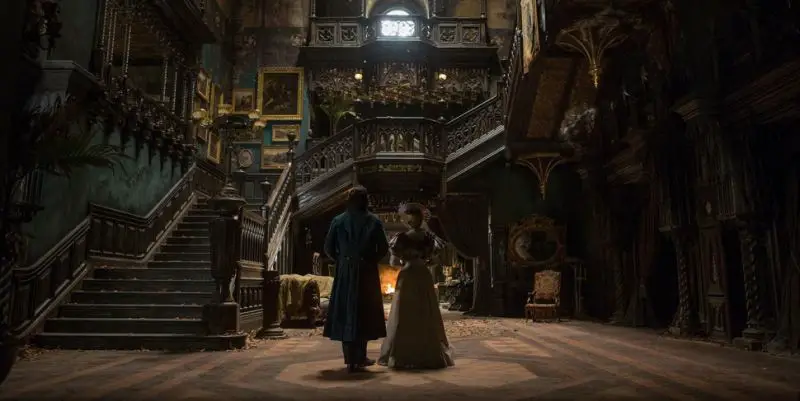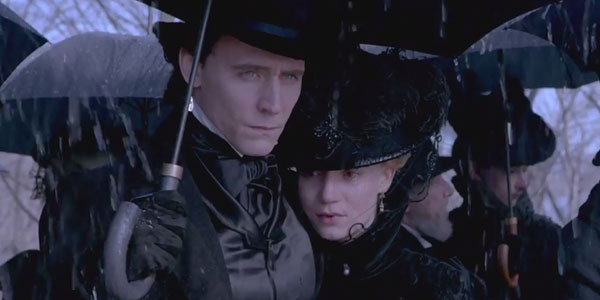CRIMSON PEAK: A Major Disappointment from a Major Filmmaker

Alistair is a 25 year old writer based in Cambridge.…
While most genre filmmakers have a hard time choosing between style and substance, Guillermo Del Toro has become the best filmmaker in the fantasy genre by giving equal weight to the visual design and emotional weight of the narrative; both complement each other in the best of his work. Even in a simple blockbuster movie like Pacific Rim, the substance is always there to be seen due to the clear love for the old-school Kaiju movies that inspired it – to date it is the only major studio tentpole blockbuster that feels like the personal passion project it was devised as.
Crimson Peak is Del Toro’s return to gothic fantasy, his first film in the English language that could be comparable to his two Spanish Civil War fairy tales, The Devil’s Backbone and Pan’s Labyrinth.
Visually Breathtaking Despite Its Problems
Although an elevated budget in comparison to The Devil’s Backbone and Pan’s Labyrinth allows him to realise one of the most beautiful sets of his entire career, for the first time the substance has alluded him. Even if Pacific Rim was emotionally empty at times, you felt a passion for him making a movie in a genre he grew up loving. In Crimson Peak, the emotions are so inconsequential it is best to ignore the narrative altogether and obsess over every minute detail of the haunted house and the period design.
Crimson Peak doesn’t even show that major passion for being part of the same gothic fantasy genre that spawned his two most beloved films – the last thirty minutes take a sharp turn into trash cinema territory, making for an uneven and tonally clashing film. A suspenseful first hour and a half that builds up to nothing but nonsensical cheap thrills that you would only expect to find in a movie from a lesser filmmaker; a work of art that quickly descends into a work of boring trash cinema.

Edith Cushing (Mia Wasikowska) has always believed in ghosts after being visited by one as a child, telling her simply to “beware of Crimson Peak”. As an adult, she is a failing author of ghost stories who keeps getting pressured by editors to write about more feminine things. Her stories end up catching the eye of British aristocrat Sir Thomas Sharpe (Tom Hiddleston), who is visiting America in order to get funding for his new invention from Edith’s wealthy industrialist father, Carter Cushing (Jim Beaver).
Cushing doesn’t want to fund this project, but coincidentally Thomas Sharpe starts wooing his daughter. Cushing demands that both Sharpe and his sister (Jessica Chastain) leave town immediately, breaking his daughter’s heart in the process. As they leave town, Cushing is killed (a plot detail I didn’t realise was supposed to be a mystery until the murderer is revealed in the most obvious plot twist this millennium) and Sharpe marries Edith, taking her back to his estate in England. From there, Edith is increasingly plagued with supernatural phenomena as her new husband and his sister become increasingly untrustworthy.
Crimson Peak is undoubtedly one of the most visually beautiful movies of the year, with the attention to detail in the Sharpe mansion being borderline breathtaking. It’s in these little moments divorced from narrative demands that Del Toro reminds you what a master director he is, by creating creepy images like rotting wood rising beneath the dilapidated floorboards, or blood-red water being released from the bathtub taps slowly turning back to its normal colour.

The first half of the movie suggests an elegant take on gothic horror that the gradual descent into less reputable territory ensures doesn’t happen. The death of Carter Cushing, head being smashed against a sink with running water still emanating, turning blood red in the process, is stylistically impeccable, foreshadowing the aforementioned scene of his daughter in the Sharpe mansion bathtub, waiting for the water to turn back to its normal shade.
Of course, there is one problem with the visual design, as the practical effects are so spellbinding that the CGI ghosts, that later appear to haunt Edith, appear obviously fake by comparison. Crimson Peak offers a feature length argument as to why practical effects are more effective than digital ones, as by endorsing both, Del Toro has ensured half of the creepiness on-screen is less than satisfying.
Tonally Jarring Performances
Another problem may be the mannered nature of the performances, all of which appear to be from different movies altogether. Tom Hiddleston and Mia Wasikowska both feel like they belong in Del Toro’s gothic kingdom, although it isn’t until the unsubtle shift in genres of the final act that you realise how little chemistry they have together and how little you are interested in their relationship.
Until then, you are won over squarely due to the fact these are two more solid performances from two solid performers, albeit both playing squarely to type. If they both belong in an elegant, old-school ghost movie, then Jessica Chastain, giving one of her worst performances, appears to be in a work of high camp cinema from the moment she appears onscreen. She delivers dark monologues about butterflies that would be more tonally effective if they weren’t delivered with a knowing wink to the audience that the other performers aren’t delivering.

As the film gets increasingly ludicrous, it becomes apparent she has clearly been studying Lena Headey’s performance as Cersei Lannister on Game of Thrones, only without the emotional weight that helps elevate that character’s story arc from mere camp. The less said about the appearance of charisma vacuum Charlie Hunnam, whose character ultimately has no bearing on the story whatsoever, the better.
More so than any other movie this year, it is impossible to define the biggest problem with the movie without launching into spoiler territory. In a broader sense, the problem is that it fulfils Del Toro’s love of foreshadowing events in the most incompetent way, foreshadowing only what is inconsequential to the narrative, leaving the jarring twists completely unexpected and all the more ludicrous for it. More focus is put on foreshadowing the amount of butterflies in the mansion than anything narratively relevant. More infuriatingly, as the movie gets sillier to the point where a critical reappraisal from this writer seems unlikely, the visual beauty is still there to be seen; the pure white snow falling into the mansion whilst the aching melodrama unfolds provides a visceral beauty that the story wishes it would, instead leaving you feeling as cold as the pure white snow falling to the ground.
Like Pan’s Labyrinth, the movie initially acts ambiguously as to whether Edith’s ghosts are real or imaginary – the sharp left turn into psychosexual potboiler territory robs the film of any interest towards her ghosts, instead of using her nightmarish visions as a parallel nightmare reflecting her home life.
Conclusion
Even though it has visual beauty that makes it required viewing on the big screen, I can’t endorse Crimson Peak or claim it is anything more significant than a disappointment. Guillermo Del Toro has made films that have underwhelmed before, but by staying so closely to the genre he is most passionate about, none of them have let me down as much as this.
Crimson Peak has divided audiences and critics – what did you think of it? Have any other major directors delivered a recent movie with so much wasted potential?
Crimson Peak is out now in the UK, US and pretty much everywhere in the world. All international release dates are here.
(top image source: Universal Pictures)
Does content like this matter to you?
Become a Member and support film journalism. Unlock access to all of Film Inquiry`s great articles. Join a community of like-minded readers who are passionate about cinema - get access to our private members Network, give back to independent filmmakers, and more.
Alistair is a 25 year old writer based in Cambridge. He has been writing about film since the start of 2014, and in addition to Film Inquiry, regularly contributes to Gay Essential and The Digital Fix, with additional bylines in Film Stories, the BFI and Vague Visages. Because of his work for Film Inquiry, he is a recognised member of GALECA, the Gay & Lesbian Entertainment Critics' Association.













